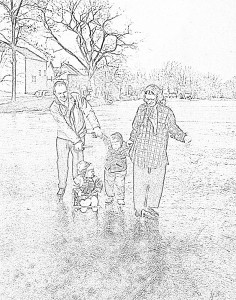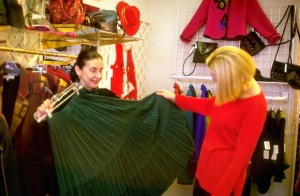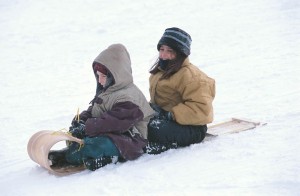
1. Where is this family skating?
They are skating outside.
2. How many people are skating in the picture?
There are three people skating in the picture.
3. Is anyone skating backwards?
No one is skating backwards. They are all skating forwards.
4. Is anyone doing a figure eight?
No, no one is doing a figure eight.
5. Is anyone making a crossover turn?
No, no one is making a crossover turn.
6. Can the baby skate?
No, the baby is too young to skate.
7. What is the baby doing instead of skating?
Instead of skating, the baby is riding in a push sled.
8. What is the father doing?
The father is pushing the baby in the baby sled while he is skating. He is also holding the hand of the big sister.
9. What type of skates does the father have?
The father has either hockey skates or figure skates.
10. What is the mother doing?
The mother is holding the hand of the big sister while she is skating.
11. What type of skates does the mother have?
It looks like the mother has hockey skates. Women’s figure skates are usually white.
12. What type of skates does the big sister have?
The big sister has beginner skates, or double-bladed skates.
13. Can the big sister skate by herself, or does she need help?
No, she cannot skate by herself. She needs help in learning how to skate.
14. Is it cold in the picture?
Yes, it is cold. The water is frozen.
15. Is anyone wearing a scarf?
Yes. The mother is wearing a head scarf to keep warm. The baby is also wearing a scarf.
16. Who is wearing a hat?
The two girls are wearing hats.
17. Who is not wearing a hat?
The father is not wearing a hat. He does not have anything on his head to keep warm. The mother is not wearing a hat, but she still has something on her head to keep warm.
18. What do the people have on their hands to keep their hands from getting cold?
The people are wearing mittens and gloves to keep their hands warm.
19. Is the family skating on an ice rink, a river, a lake, or a pond?
The family is not skating on an ice rink. They are outdoors, skating on a river or a lake.
20. How much snow is there on the ice?
There is no snow on the ice.
21. What must be done if there is snow on the ice and someone wants to go skating?
If there is snow on the ice and someone wants to go skating, the ice must be cleared and the snow shoveled off.
22. How thick should the ice be for it to be safe for skating?
The ice should be at least 8 – 10 cm thick for it to be safe for skating.
23. What happens if the ice is too thin to skate on?
If the ice is too thin to skate on, it is dangerous. The ice could break, and the skater could fall in and drown.
24. Why are there cracks in the ice?
There are cracks in the ice because ice expands as it freezes.
25. Is it safe to go skating if there are cracks in the ice?
If the cracks are from the ice expanding as it gets colder, it is usually okay to skate on. If the cracks come from someone breaking the ice to open it up for water, it is probably not safe to go skating there.
Paragraph: Going Ice Skating
Have you ever been ice skating? What was it like? Was it outdoors, or at a rink? Did you fall down a lot when you first learned to ice skate? If you have never been ice skating, write about what you think would be fun about ice skating (or what would not be fun, if you don’t like it).
When I was younger, I grew up near a river. In the summertime, we went swimming, fishing, and boating on the river. But in the wintertime, the river would freeze over, and then we could go ice skating. My father would always check the ice first to make sure it was thick enough and safe for skating. If there was snow on the ice, we had to shovel it off before we could go skating there. We could make as big as rink as we wanted, but a bigger rink also meant that there was a lot more snow shoveling to do before we could skate there.
When I first learned to ice skate, I had double-bladed skates. They were strapped on over my snow boots. The double blades made it easier for me to become accustomed to skating on the ice. After I got better at skating, I could skate on single blades. Then I wore an old pair of hockey skates that had belonged to one of my brothers. The hockey skates had a blade attached to the bottom of the shoe, so I had to take off my boots, put on the skates, and then lace them up tightly to wear them. Since it is difficult to lace skates when wearing mittens or gloves, I had to take off my mittens when I laced up the skates. It was very cold, and by the time I finished putting on my skates, my fingers were numb. I couldn’t wait to put the mittens back on.
As I got better at skating, I learned how to skate backwards and skate around corners using a crossover turn. I never had any lessons, so I don’t know how to do anything fancy like a figure eight or spins. But at least I can skate without falling down, and I can skate fast enough to have some fun. I enjoy skating, and look forward each winter to being able to go out and get some exercise and fresh air.
Google




